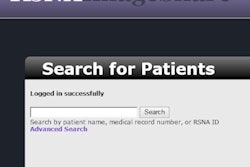Cloud-based systems can offer a secure and efficient means of sharing images and radiology reports, according to a presentation at the recent RSNA 2011 meeting in Chicago.
With no hardware or software to buy, cloud-based systems provide platform-independent access to images, reports, and other documents, overcoming the limitations of legacy-based approaches to radiology image and information sharing, said presenter Dr. Mark Kovacs, a radiology resident at Santa Barbara Cottage Hospital.
Lack of access to patient data between healthcare providers is a big problem today. Each site or enterprise basically acts as an independent data silo, which contributes to fragmentation of healthcare data and, in turn, to unnecessary imaging studies, Kovacs said.
"It's been estimated that $30 billion a year in excess costs are due to inappropriate utilization or duplicate studies," he said. "This represents not just a cost issue; it also leads to excess radiation exposure for patients, which is an extremely important topic."
Legacy methods of radiology information exchange suffer from many limitations, Kovacs said. The old-fashioned fax is a slow and nonsecure technology that can share only limited information; high-resolution images are not available. Virtual private networks (VPNs) are powerful but costly and are difficult to set up and maintain.
"And they can represent a substantial security risk," he said.
Today's popular method of using CDs requires physical transport, which can lead to transfer delays and potentially lost or damaged disks. Sometimes family members will forget to bring them, Kovacs said.
In addition, the outside media are not always readable and viewing software can result in problems, including slow loading times and cumbersome navigation capabilities, Kovacs said.
Journeying to the cloud
Santa Barbara Cottage Hospital has experienced success with its eMix cloud-based patient information sharing service (DR Systems), according to Kovacs. The cloud-based service allows images and DICOM-"wrapped" reports to be made available over the Internet via a HIPAA-compliant, secure, efficient, and platform-independent system, he said.
"In simple terms, imagine that you have a cloud in the sky, and in it you've got servers, applications, storage space, and databases," Kovacs said. "Via the Internet, people can access the cloud and all of its technologies that are within."
In contrast to the legacy methods of radiology information exchange, patients benefit from the near-immediate access to imaging exams and reports, including discharge summaries, he said.
"This efficient way of handling data is especially important in the trauma setting when time is really of the essence," Kovacs said.
In addition, this availability reduces duplicate studies and their additional radiation exposure, he said. Studies can also be shared with consultants anywhere in the world.
As for the healthcare enterprise, it benefits from not having to buy hardware or software or to implement custom interfaces. It also gets a single, unified access portal for all outside data and a vendor-neutral system, Kovacs said. It features an eight-layer security policy and HIPAA compliance, as well as instant access to software enhancements without site-specific downtime.
The service has also been in place at a number of other institutions, including Virginia Commonwealth University (VCU) Medical Center, where Kovacs went to medical school and completed his internship. Like many hospitals, VCU relied on CDs for image transfer in the trauma transfer setting, and it was affected by that method's drawbacks, including unreliable media, incompatible formats, and security risks from having to keep track of the CDs, he said. There were also delays associated with waiting for the CD to arrive.
In January 2011, however, the institution's radiology department investigated and decided to implement this cloud-based system. After launching the service that month, approximately 17% of studies were imported via the cloud-based system instead of CDs. That number doubled to 34% by September, Kovacs said.
"They've found this to be an efficient and reliable way to import data," he said.




















